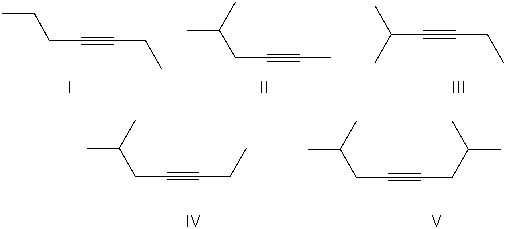A) Acetylide anions are resonance stabilized.
B) The 4 electrons of the acetylide anion better stabilize a negative charge.
C) The electronegativity of sp carbons is greater than that of sp2 carbons.
D) The electronegativity of sp carbons is less than that of sp2 carbons.
E) Acetylene has only two hydrogen atoms while ethylene has four.
G) B) and D)
Correct Answer

verified
Correct Answer
verified
Multiple Choice
What is the major product of the reaction shown below? 
A) (E) -2,3-dichloro-2-hexene
B) (Z) -2,3-dichloro-2-hexene
C) 2,2-dichlorohexane
D) 3,3-dichlorohexane
E) 2,2,3,3-tetrachlorohexane
G) A) and D)
Correct Answer

verified
Correct Answer
verified
Multiple Choice
A dihalide in which the halogens are attached on adjacent carbons is called a _______________ dihalide.
A) vicinal
B) geminal
C) vinylic
D) allylic
E) cis
G) A) and C)
Correct Answer

verified
Correct Answer
verified
Multiple Choice
What is the expected major final product of the reaction sequence shown below? 

A) I
B) II
C) III
D) IV
E) None of the shown products will be produced.
G) B) and D)
Correct Answer

verified
Correct Answer
verified
Multiple Choice
What is the IUPAC name for the molecule shown below? 
A) 5,6,6-trimethyl-1-heptyne
B) 5-tert-butyl-1-hexyne
C) 2,2,3-trimethyl-6-heptyne
D) 2,2,3-(3-butynyl) butane
E) sec-butyl-tert-butylacetylene
G) B) and C)
Correct Answer

verified
Correct Answer
verified
Multiple Choice
For the reaction shown, select the expected major organic product. 

A) I
B) II
C) III
D) IV
E) V
G) A) and B)
Correct Answer

verified
Correct Answer
verified
Multiple Choice
Identify the final product for the following reaction. 

A) I
B) II
C) III
D) IV
E) V
G) None of the above
Correct Answer

verified
Correct Answer
verified
Multiple Choice
For the reaction shown below, the resulting stereochemistry of the expected product is best described as: 
A) (R,E)
B) (S,E)
C) (R,Z)
D) (S,Z)
E) only (S)
G) A) and E)
Correct Answer

verified
Correct Answer
verified
Multiple Choice
What is the IUPAC name for the molecule shown below? 
A) (E) -4-isopropyloct-3-en-5-yne
B) (Z) -4-isopropyloct-3-en-5-yne
C) (E) -5-isopropyloct-5-en-3-yne
D) (Z) -5-isopropyloct-5-en-3-yne
E) (E) -4-(2-methylethyl) oct-3-en-5-yne
G) B) and C)
Correct Answer

verified
Correct Answer
verified
Multiple Choice
For the reaction below, which of the alkynes listed would be expected to produce the product under the conditions shown? 

A) I
B) II
C) III
D) IV
E) V
G) All of the above
Correct Answer

verified
Correct Answer
verified
Multiple Choice
What is the expected major final product of the reaction sequence shown below? 

A) I
B) II
C) III
D) IV
E) V
G) D) and E)
Correct Answer

verified
Correct Answer
verified
Multiple Choice
For the reaction shown, select the expected major organic product. 

A) I
B) II
C) III
D) IV
E) V
G) B) and C)
Correct Answer

verified
Correct Answer
verified
Multiple Choice
For the reaction shown, select the expected major organic product. 

A) I
B) II
C) III
D) IV
E) V
G) None of the above
Correct Answer

verified
Correct Answer
verified
Multiple Choice
For the reaction shown, which of the compounds listed would be the expected enol intermediate? 

A) I
B) II
C) III
D) IV
E) V
G) A) and C)
Correct Answer

verified
Correct Answer
verified
Multiple Choice
What is the IUPAC name for the molecule shown below? 
A) 6-bromo-3-octyne
B) 6-bromo-6-methyl-3-heptyne
C) 2-bromo-2-methyl-4-heptyne
D) 6-bromo-6,6-dimethyl-3-hexyne
E) 2-bromo-4-octyne
G) A) and C)
Correct Answer

verified
Correct Answer
verified
Multiple Choice
Determine which compound will react with sodium in liquid ammonia to form trans-3-hexene.
A) cis-3-hexene
B) trans-2-hexene
C) 3-hexyne
D) 2-hexyne
E) cis-2-hexene
G) A) and B)
Correct Answer

verified
Correct Answer
verified
Multiple Choice
Which of the compounds shown below would be the most likely product expected from the reaction scheme shown? 

A) I
B) II
C) III
D) IV
E) V
G) B) and D)
Correct Answer

verified
Correct Answer
verified
Multiple Choice
For the reaction shown, select the expected major organic product. 

A) I
B) II
C) III
D) IV
E) V
G) C) and D)
Correct Answer

verified
Correct Answer
verified
Multiple Choice
Rank the following carbanions in order of increasing base strength. 
A) I < II < III
B) II < III < I
C) III < II < I
D) III < I < II
E) II < I < III
G) B) and E)
Correct Answer

verified
Correct Answer
verified
Multiple Choice
Of the reaction conditions provided below, which would be expected to convert 1 mole of 4-methyl-1-pentyne into 2-methylpentane?
A) H2, Lindlar's catalyst
B) Na, NH3(l)
C) 2 moles of HCl
D) 2 moles H2, Pt
E) 1 mole H2, Pt
G) A) and E)
Correct Answer

verified
Correct Answer
verified
Showing 81 - 100 of 177
Related Exams